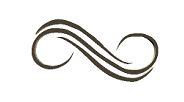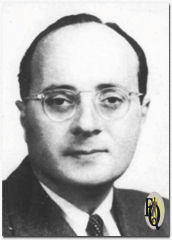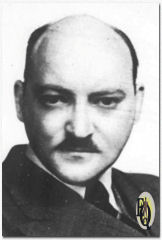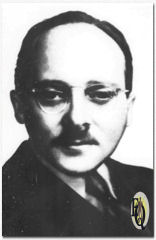
 |
![]()
Kurt Sercu |


|
"TWO-IN-ONE
Portraits" by Dushan Hill Photography by Gorska-Hill You can have fun superimposing portrait images. Two methods are described here, one of which was used in photographing a well-known author. In all the realm of trick photography, the making of composite portraits can produce some of the most interesting effects. It isn't hard to do, either, and it presents many possibilities for puzzling and amusing your friends. Combination portraiture recently was used in filling an interesting commercial assignment. This occurred when the Frederick A. Stokes Co., publishers of the Ellery Queen mystery stories, wanted a picture of Ellery himself. Since Ellery actually is two men, Manfred B. Lee and Frederic Dannay, the photographer had to blend their two faces into one portrait image in order to fill the bill. There are two possible ways of making such a combination portrait—one by using the camera, and the other by using the enlarger. The first method applies when you can start from scratch—that is, when you can get the subjects to pose, and can shoot the negatives expressly for the purpose of combination. This was the case with Ellery Queen. Lee and Dannay were asked to come to the studio dressed as nearly alike as possible, so as to avoid confusion in the final print with reference to neckties, collars, and suits. |
|
 |
Lee was photographed first. When the desired pose was obtained (front face is best in this sort of work), a sheet of colorless cellophane was placed over the groundglass of the camera, being hinged at the top with transparent tape. This cellophane did not obscure the view, and could be lifted up for direct inspection of the groundglass image. Lee’s eyes (especially the highlights), and a rough outline of his face and shoulders then were drawn on the cellophane with a soft pencil, and the exposure was made. |
 |
Next, Dannay was asked to take Lee’s place, duplicating the latter’s pose as nearly as possible. The camera then was moved back and forth until Dannay’s eyes coincided on the cellophane with the penciled-in eyes of Lee. General positions of head and shoulders then were made to conform with the outline on the cellophane, and the second exposure was made. |
 |
Manfred Lee (top left) and Frederic Dannay (center) are two authors who write books jointly under the name of Ellery Queen. At the immediate left is a composite portrait of the two men, made on a single negative. The text explains how this was effected. |
|
In making the final combination print,
which is reproduced as one of the illustrations with this
story, one negative was placed over the other and the two
images were registered as closely as possible. Then the
printing was done. The final print was airbrushed to remove
double lines and other evidences of lack of registration.
However, the airbrushing in this case was done solely to
make this print suitable for publication, and this step in
the procedure can be omitted for ordinary purposes.
In addition to the method just described, there’s another way of making combination portraits when the negatives are of different sizes and the distance between the subjects’ eyes varies somewhat. In this case the enlarger is used instead of the camera. The first negative is placed in the enlarger and focused on the easel, and a sheet of red cellophane is placed over the easel and hinged at one end as was done with the camera groundglass in the other case. The eyes and general contour are drawn on the cellophane in the same way. The cellophane then is lifted up, a sheet of enlarging paper is put in place, and an exposure is made. Then the cellophane is placed over the exposed sheet of paper to protect it, while the first negative is removed from the enlarger and the second one inserted and adjusted. The eyes in the second negative then are matched with the eyes already drawn on the red cellophane, the head and shoulder contours being matched up as well as possible. The enlarger light is turned off, the cellophane is lifted up out of the way, and the second exposure is made. Some experimenting will be necessary in order to gage the right exposure for each negative. It’s important that neither of the exposures be too heavy or too light, the object being to match them up as nearly as possible. This “double enlarging’ can be repeated with almost any number of negatives, as long as you're careful to match the eyes and the general head and shoulder contours in each case. Of course, the more multiple exposures you make the more carefully you must figure each exposure. The first of the two methods obviously can be attempted only by those using cameras equipped with groundglass focusing screens. And for best results it’s wise to employ a camera large enough to afford pretty accurate registration of images on the film. The enlarging method is open to anyone who can get the use of an enlarger. It works best when the various negatives are similar as to pose of subject, size, and image density. Dissimilar backgrounds frequently will get sufficiently mixed up to come out almost neutral in the final multiple print, but you should watch the register of white collars, etc. In place of airbrushing, the amateur can do much in the way of local bleaching on the finished print. There’s nothing involved about making these multiple portraits, whichever way you do it. Try it out—you’ll be pleasantly surprised, and so will your friends upon seeing themselves in one of these combination pictures.—} (Popular Photography, Bonnier Corporation, Jul 1941) |
|

![]() b a c k t o E x
t r a , E x t r a
b a c k t o E x
t r a , E x t r a
|
| Introduction | Floor Plan | Q.B.I. |
List of Suspects | Whodunit? | Q.E.D. | Kill as directed | New | Copyright Copyright © MCMXCIX-MMXXV Ellery Queen, a website on deduction. All rights reserved. |